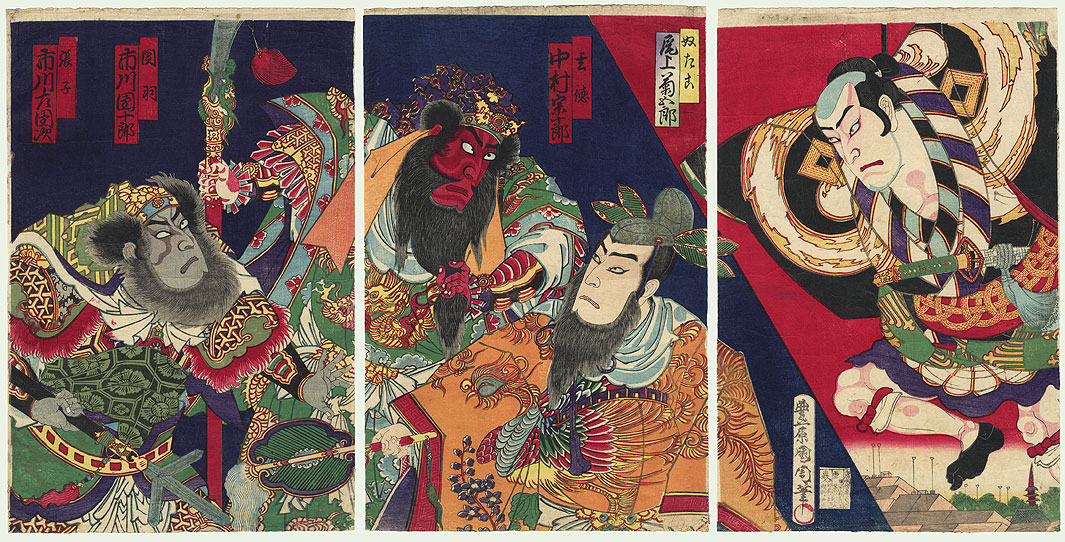| |
Kunichika
|

'Three Kingdoms Leaders and
Man Kite'
"Three Kingdoms" ("SangGoKushi, "三国志")
1879
"Three Kingdoms" ("SangGoKushi, "三国志")
1879
Comment - Kabuki triptych with a
diagonally divided composition featuring two scenes. The left
image features the three leaders from the historical tale
"Romance of the Three Kingdoms," a story about the three
warring kingdoms in China during the third century. After much
debate, the warriors decide to take an oath of brotherhood,
swearing to serve each other and the state rather than
continue fighting amongst themselves. The bearded generals
wear exotic clothing and armor, and in the center, Kan'u grips
a giant glaive with a blade issuing from a dragon's mouth. The
actors names and role are written in the red cassettes.
At right, an actor appears as a Yakko-dako (奴凧) or man kite, wearing the distinctive costume of a yakko or low-ranking servant, decorated with a crest on both sleeves. He hangs from a cord, hinting to a real kabuki theater scene. His kimono sleeves stretched out beside him like wings, glaring unhappily as he looks down. The actor Onoe Kikugoro (尾上菊五郎) representing the Yakko kite,is written in the white cassette on top right of the center panel, the yellow cassete gives his his role ((yakko tako, 奴たこ). "Baiko", the nickname of Onoe Kikugoro, is dressed in a New Year's Yakko-kite dance costume for the role of Kumonnaju Shishin. There are several graphical presentations on woodblock prints of "Baiko" dressed in a Yakko-kite costume.
The other actors are (from right to left) Nakamura Sōjūrō (中村宗十郎) as Gentoku (玄徳), the mighty warlord in the late Eastern Han and later emperor Wu, the red faced Ichikawa Danjūrō (市川団十郎) as Kan'u (関羽), a general of Eastern Han, and the grey faced Ichikawa Udanji (市川右団次) as general Hariko (張子).
Series - ~
Artist - see Biography
Signature - "drawn by Toyohara Kunichika" ( "Toyohara Kunichika hitzu", "豊原国周筆") on right panel, white oval Ootoshidama cassette
Publisher - Asano Eizō (浅野栄蔵) white cassette, next to signature cassette
Image Size - 35.6cm X 72.1cm (14" x 28 3/8") + margins as shown
Condition - triptych, three panels attached at the seams; nishiki-e (cloured woodblock); Vertical ôban (ôban tate-e);
At right, an actor appears as a Yakko-dako (奴凧) or man kite, wearing the distinctive costume of a yakko or low-ranking servant, decorated with a crest on both sleeves. He hangs from a cord, hinting to a real kabuki theater scene. His kimono sleeves stretched out beside him like wings, glaring unhappily as he looks down. The actor Onoe Kikugoro (尾上菊五郎) representing the Yakko kite,is written in the white cassette on top right of the center panel, the yellow cassete gives his his role ((yakko tako, 奴たこ). "Baiko", the nickname of Onoe Kikugoro, is dressed in a New Year's Yakko-kite dance costume for the role of Kumonnaju Shishin. There are several graphical presentations on woodblock prints of "Baiko" dressed in a Yakko-kite costume.
The other actors are (from right to left) Nakamura Sōjūrō (中村宗十郎) as Gentoku (玄徳), the mighty warlord in the late Eastern Han and later emperor Wu, the red faced Ichikawa Danjūrō (市川団十郎) as Kan'u (関羽), a general of Eastern Han, and the grey faced Ichikawa Udanji (市川右団次) as general Hariko (張子).
Series - ~
Artist - see Biography
Signature - "drawn by Toyohara Kunichika" ( "Toyohara Kunichika hitzu", "豊原国周筆") on right panel, white oval Ootoshidama cassette
Publisher - Asano Eizō (浅野栄蔵) white cassette, next to signature cassette
Image Size - 35.6cm X 72.1cm (14" x 28 3/8") + margins as shown
Condition - triptych, three panels attached at the seams; nishiki-e (cloured woodblock); Vertical ôban (ôban tate-e);
Copyright 2008 ff: Hans P. Boehme